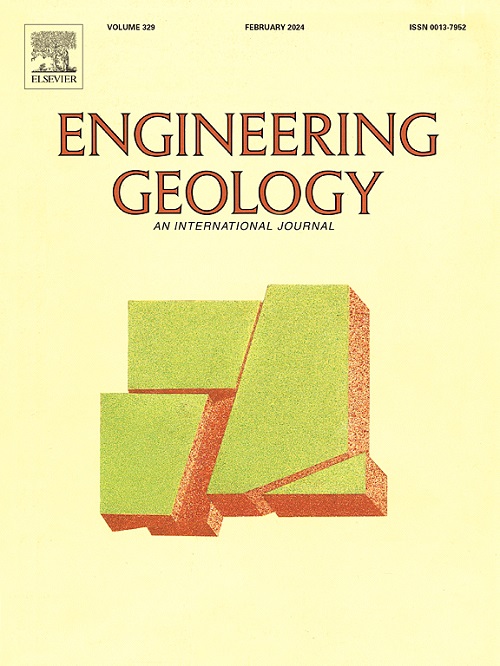基于物理和数据驱动的滑坡长期演化:从反演到预测
IF 8.4
1区 工程技术
Q1 ENGINEERING, GEOLOGICAL
引用次数: 0
摘要
利用数字技术提高防灾减灾公共服务能力是地质灾害研究的重点。本研究拓展了数值模拟在地质灾害预报中的应用,包括现状反演、未来预测技术和数据集成等方面的研究。以原型系统状态感知数据和数字孪生模型为核心数据组件,采用物质点法(Material Point Method, MPM)构建了具有长期预测能力的地质灾害模拟框架。从灾难场景中提取关键要素,建立灾难场景孪生模型,作为数字仿真的数据存储介质。利用灾害原型场景的状态感知进行系统状态反演,优化物理力学参数的选择。然后使用岩土材料的物理力学模型对孪生模型进行更新,以预测灾害的未来发展。以太河滑坡为例,根据监测数据,结合岩土材料强度退化的时变特征,导出了原型系统状态。利用数据和物理原理驱动的孪生模型进行灾害状态反演和预测模拟。对比孪生模型与灾害原型之间的滑坡变形方向、范围和局部崩塌位置,进一步实现孪生模型输入参数的约束和优化。在此基础上,进行了滑坡的长期稳定性模拟,整合了岩土材料的强度演变,将时间跨度特征纳入滑坡双胞胎模型的长期行为。对未来10年太河滑坡灾害的演变进行了预测。提出了一种灾害情景数字孪生模型,扩展了传统的灾害领域数值模拟。通过整合数据和物理驱动的方法,它创建了一个具有时间泛化能力的仿真框架。这促进了数字技术在工程地质中的应用,提高了灾害预测的准确性。本文章由计算机程序翻译,如有差异,请以英文原文为准。
Physics-based and data-driven long-term evolution of a landslide: From inversion to prediction
Leveraging digital technology to improve public service capabilities in disaster prevention and mitigation is a key focus in geological hazard research. This research expands the utilization of numerical simulations for geological disaster forecasting, including studies on current-state inversion, future prediction techniques, and data integration. A geological hazard simulation framework endowed with long-term predictive capabilities was developed using the Material Point Method (MPM), with sensing data of the prototype system state and digital twin models constitute the core data components. A disaster-scenario twin model was established by extracting key elements from disaster scenarios, serving as the data storage medium for digital simulations. State sensing of the disaster prototype scenario was used to conduct system state inversion and optimize the selection of physico-mechanical parameters. The twin model was then updated using physico-mechanical models of geotechnical materials to forecast the future development of the disaster. Taking the Taihe landslide as a case study, the prototype system state was derived from monitoring data, along with the time-dependent characteristics of strength degradation of geotechnical materials. Inversion of disaster state and predictive simulations were performed using the twin model driven by data and physical principles. The landslide deformation direction, range, and local collapse locations between the twin model and the disaster prototype were compared to further achieve the constraints and optimization of the input parameters of the twin model. Building on this, long-term stability simulations for the landslide were performed, integrating the strength evolution of geotechnical materials to incorporate time-span characteristics in the landslide twin model for long-term behavior. The evolution of future disasters of the Taihe landslide over the next decade was forecasted. A disaster-scenario digital twin model, extending traditional numerical simulation in disaster fields, was developed. By integrating data and physics-driven approaches, it creates a simulation framework with temporal generalization capability. This advances the utilization of digital technologies in engineering geology and improves the accuracy of disaster prediction.
求助全文
通过发布文献求助,成功后即可免费获取论文全文。
去求助
来源期刊

Engineering Geology
地学-地球科学综合
CiteScore
13.70
自引率
12.20%
发文量
327
审稿时长
5.6 months
期刊介绍:
Engineering Geology, an international interdisciplinary journal, serves as a bridge between earth sciences and engineering, focusing on geological and geotechnical engineering. It welcomes studies with relevance to engineering, environmental concerns, and safety, catering to engineering geologists with backgrounds in geology or civil/mining engineering. Topics include applied geomorphology, structural geology, geophysics, geochemistry, environmental geology, hydrogeology, land use planning, natural hazards, remote sensing, soil and rock mechanics, and applied geotechnical engineering. The journal provides a platform for research at the intersection of geology and engineering disciplines.
 求助内容:
求助内容: 应助结果提醒方式:
应助结果提醒方式:


